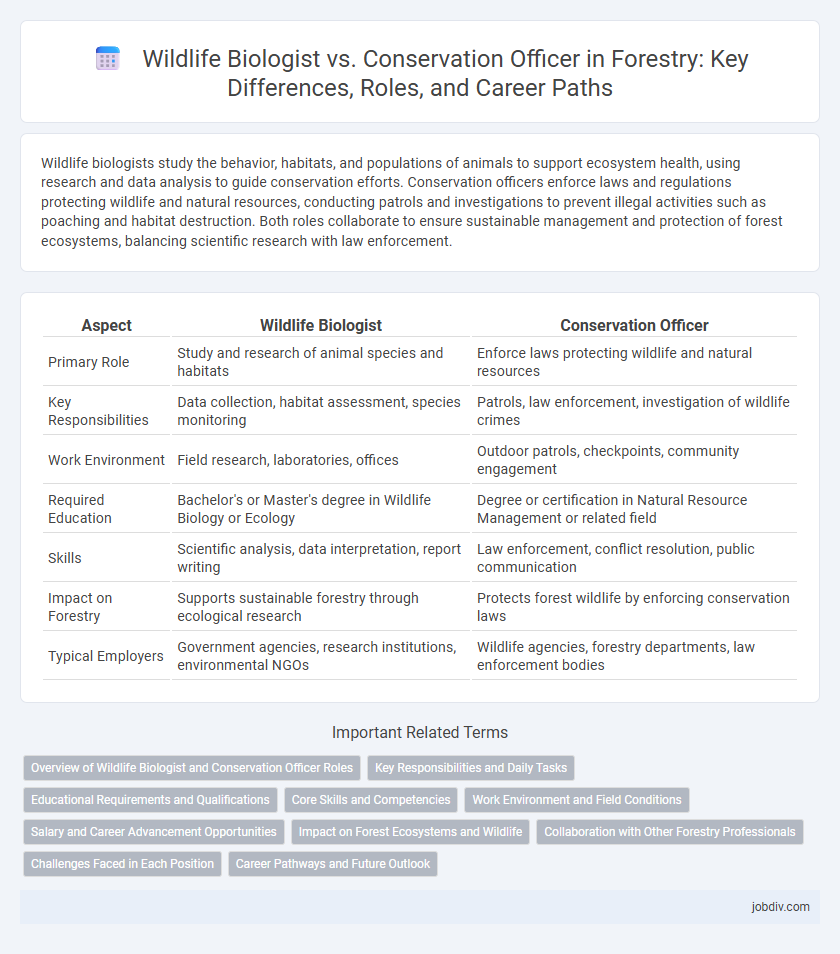Wildlife biologists study the behavior, habitats, and populations of animals to support ecosystem health, using research and data analysis to guide conservation efforts. Conservation officers enforce laws and regulations protecting wildlife and natural resources, conducting patrols and investigations to prevent illegal activities such as poaching and habitat destruction. Both roles collaborate to ensure sustainable management and protection of forest ecosystems, balancing scientific research with law enforcement.
Table of Comparison
| Aspect | Wildlife Biologist | Conservation Officer |
|---|---|---|
| Primary Role | Study and research of animal species and habitats | Enforce laws protecting wildlife and natural resources |
| Key Responsibilities | Data collection, habitat assessment, species monitoring | Patrols, law enforcement, investigation of wildlife crimes |
| Work Environment | Field research, laboratories, offices | Outdoor patrols, checkpoints, community engagement |
| Required Education | Bachelor's or Master's degree in Wildlife Biology or Ecology | Degree or certification in Natural Resource Management or related field |
| Skills | Scientific analysis, data interpretation, report writing | Law enforcement, conflict resolution, public communication |
| Impact on Forestry | Supports sustainable forestry through ecological research | Protects forest wildlife by enforcing conservation laws |
| Typical Employers | Government agencies, research institutions, environmental NGOs | Wildlife agencies, forestry departments, law enforcement bodies |
Overview of Wildlife Biologist and Conservation Officer Roles
Wildlife biologists conduct scientific research to study animal behavior, habitat, and population dynamics, providing data essential for forest ecosystem management and species conservation. Conservation officers enforce wildlife laws, regulate hunting and fishing activities, and ensure the protection of natural habitats within forested areas. Both roles collaborate to maintain biodiversity and support sustainable forestry practices through science and law enforcement.
Key Responsibilities and Daily Tasks
Wildlife biologists conduct scientific research to study animal behavior, habitats, and population dynamics, using data collection and analysis to inform conservation strategies. Conservation officers enforce wildlife laws, monitor protected areas, and engage with the public to prevent illegal activities like poaching and habitat destruction. Both roles are essential in managing forest ecosystems, but wildlife biologists focus on research and data, while conservation officers emphasize law enforcement and community education.
Educational Requirements and Qualifications
Wildlife Biologists typically require a bachelor's degree in wildlife biology, ecology, or environmental science, with many employers preferring candidates holding a master's degree or higher for advanced research roles. Conservation Officers usually need post-secondary education in natural resource management, environmental science, or law enforcement, often complemented by specialized training in wildlife laws and public safety. Both professions demand strong knowledge of local ecosystems, wildlife regulations, and fieldwork skills, but Conservation Officers emphasize law enforcement qualifications alongside environmental expertise.
Core Skills and Competencies
Wildlife Biologists possess advanced expertise in ecology, species behavior, and data analysis, enabling them to conduct field research and develop conservation strategies based on scientific evidence. Conservation Officers specialize in law enforcement, public safety, and resource management skills to ensure compliance with environmental regulations and protect wildlife habitats. Both roles require strong communication, problem-solving abilities, and knowledge of wildlife laws, but Wildlife Biologists focus more on research, while Conservation Officers emphasize enforcement and community engagement.
Work Environment and Field Conditions
Wildlife biologists typically work in diverse natural habitats such as forests, wetlands, and grasslands, conducting research outdoors in varying weather conditions to study animal behavior and ecosystems. Conservation officers operate primarily in the field enforcing laws and regulations, often patrolling remote wilderness areas or public lands under challenging terrain and climate conditions. Both roles demand physical endurance and adaptability, but conservation officers frequently encounter direct human interaction and law enforcement scenarios.
Salary and Career Advancement Opportunities
Wildlife Biologists typically earn an average salary ranging from $50,000 to $85,000 annually, with career advancement opportunities in research, academia, and environmental consultancy. Conservation Officers generally have a salary range between $45,000 and $75,000 per year, often progressing to supervisory roles within wildlife management agencies or law enforcement divisions. Both careers offer specialized paths, but Wildlife Biologists tend to have broader options in scientific research and policy development, while Conservation Officers advance through enforcement and regulatory positions.
Impact on Forest Ecosystems and Wildlife
Wildlife biologists conduct research to understand animal behavior and habitat needs, directly influencing forest ecosystem health through data-driven conservation strategies. Conservation officers enforce laws protecting wildlife and natural resources, mitigating human impact and preventing illegal activities such as poaching and habitat destruction. Both roles are vital for maintaining biodiversity and ensuring sustainable forest management practices.
Collaboration with Other Forestry Professionals
Wildlife biologists and conservation officers collaborate extensively with forestry professionals to ensure sustainable ecosystem management and biodiversity conservation. Wildlife biologists provide scientific data on species populations and habitats, guiding forestry practices to minimize environmental impact. Conservation officers enforce regulations and work alongside forestry managers to monitor compliance and promote responsible resource use.
Challenges Faced in Each Position
Wildlife biologists often face challenges related to habitat fragmentation and the need for extensive field research to monitor species populations accurately. Conservation officers encounter difficulties enforcing environmental laws, managing human-wildlife conflicts, and ensuring compliance with conservation regulations. Both roles require balancing ecological preservation with increasing human activities that threaten natural ecosystems.
Career Pathways and Future Outlook
Wildlife biologists primarily focus on studying animal behavior, habitat, and ecosystems to inform conservation strategies, often requiring advanced degrees in biology or ecology. Conservation officers enforce laws protecting wildlife and natural resources, blending fieldwork with public education and typically needing certification in wildlife management or law enforcement. The future outlook for both careers is promising due to increasing global emphasis on biodiversity preservation and environmental regulations.
Wildlife Biologist vs Conservation Officer Infographic

 jobdiv.com
jobdiv.com